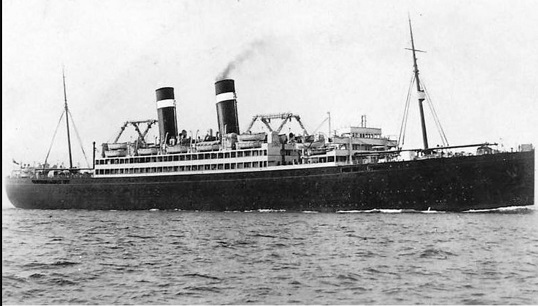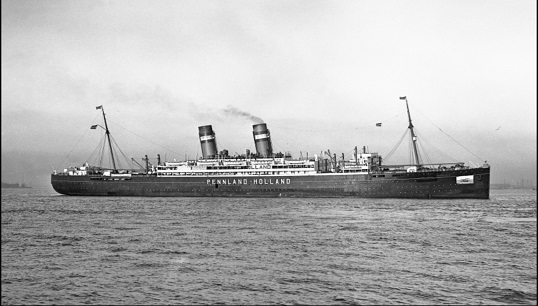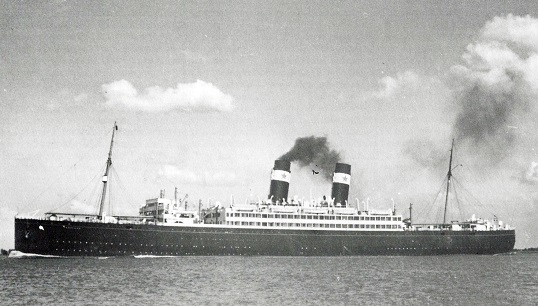Pennland

The build
The Pennland was built in Belfast by Harland & Wolff, with construction beginning in November 1913. The passenger liner had a grt of 16,322 and was designed to carry up to 2,100 passengers. The 575ft (175.4m) long triple-screw ship had a service speed of 16 knots and was powered by two-triple expansion engines and an exhaust steam turbine.
Ownership
The Pennland was originally ordered for the American Line with the name Pittsburgh, as part of a series of ships intended to dominate transatlantic services under the ownership of the New York-based International Mercantile Marine Company (IMM).
Liverpool firm Frederick Leyland & Co took over in January 1925, after changing travel routes and operating by another IMM subsidiary - the Belgium-based Red Star Line.
The Pittsburgh became the Pennland in 1935, after the company ran into financial problems and was sold by IMM to the German owner Arnold Bernstein.
In June 1939, the Pennland was sold to Holland America Line and put under the Dutch flag.
The Pennland was soon taken over by the Dutch government while in New York in May 1940, and was then chartered to the British Ministry of Transport to operate as a troopship under Dutch control.



Deployments
Rather than joining the America Line, the Pittsburgh entered service in 1922 with a maiden voyage from Liverpool to Philadelphia and Boston under the UK flag, and in the colours of the IMM’s British subsidiary White Star Line.
In April 1923, the ship was struck by a huge wave in the Atlantic which wrecked the wheelhouses and chart room, flooded several cabins, and injured the master and several crew.
The Pittsburgh was then switched to run the route linking Antwerp, Southampton, Cherbourg and New York, operated by the Red Star Line.
Renamed the Pennland in early 1926, the ship ran Red Star’s Antwerp-New York service until 1935, when it was then sold to Arnold Bernstein. After a refit in Kiel and a switch to the German flag in early 1935, the Pennland continued to operate between Antwerp and New York and stayed on the routed after being sold to Holland America Line.
In May 1940, after being fitted out in Liverpool for its new role as a troopship, it undertook a series of trooping voyages across the Atlantic and around Africa. The Pennland also transported German and Italian prisoners of war.
Pennland Fact File
What year was the Pennland launched?
The Pennland was launched in 1920 due to the First World War breaking out.
What was the Pennland’s original name?
The Pennland was originally named Pittsburgh under the ownership of the International Mercantile Marine Company (IMM).
How big was the Pennland?
The Pennland was 575ft (175.4m) long with a grt of 16,322.
When did the Pennland end its service?
The Pennland ended its service in early 1941, after it was attacked by German aircraft.
Claim to fame
In November 1922, the Pittsburgh rescued the 45-crew of the Italian ship Monte Grappa, which was sinking in the Atlantic.
The most notable period of the Pennland’s service was its time as a British troopship during the Second World War. Under Dutch control, in early 1941 the Pennland was attacked by German aircraft while helping evacuate troops from Greece.
Four crew members were killed and chief officer Pieter van Beelen took command after the master, Captain Johan van Dulken, was injured. The crew abandoned ship and were picked up by the British destroyer HMS Griffin, which then shelled and sank the Pennland.
Captain van Dulken was awarded the British Distinguished Service Cross in December 1941 and the Dutch Bronze Cross in the following year. Chief officer van Beelen and the ship’s purser, Albert la Grange, received the Dutch Cross of Merit in recognition of their calmness and bravery under fire.
Contribute
Are you knowledgeable about this vessel?
Submit your contribution to this article to our editorial team.
Write to usView more ships of the past
HMS Beagle
Launched 200 years ago, HMS Beagle has been described as one of the most important ships in history – thanks to the observations on evolution and natural selection that its famous passenger Charles Darwin made during a five-year voyage around the world between 1831 and 1836.
Common.ReadMoreHMS Beagle
Oxfordshire
The Oxfordshire had a 34-year long career as an emigrant ship, passenger liner and cruiseship.
Common.ReadMoreOxfordshire
Ruahine
Entering into service just over 70 years ago, the Ruahine was the last passenger-carrying ship built for the New Zealand Shipping Company (NZSC), and the third to bear the name – which means 'wise woman' in Māori.
Common.ReadMore